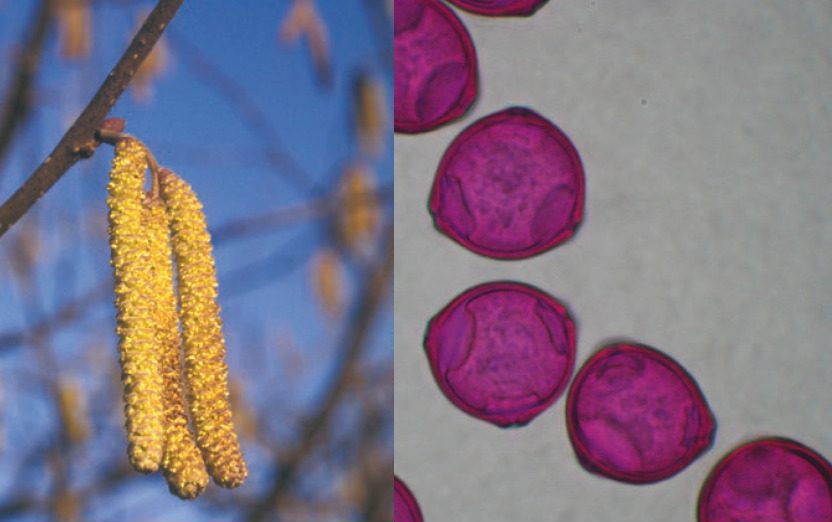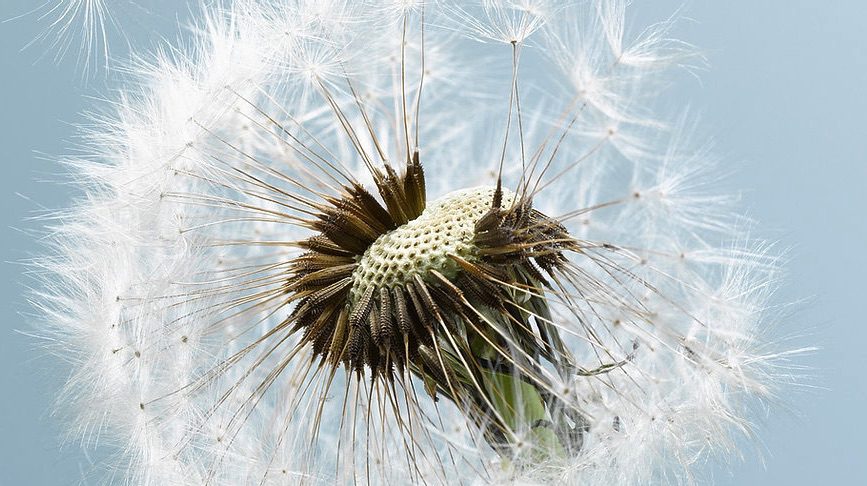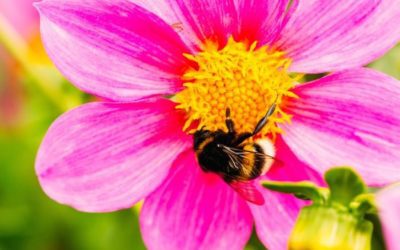Also known as seasonal allergic rhinitis – inflammation of the nose. Some plants and some trees produce a powder called pollen. People are allergic to different pollens. Tree pollen during the spring, grass pollen during the summer, and weed pollen during the fall. Common symptoms are itchy throat, red itchy watery eyes, sneezing, coughing, runny nose, and swelling around the eyes. If you experience these symptoms, we recommend you see a doctor to determine which of the pollens you are allergic to. The doctor will do a skin prick test or SPT test. After about 20 min you will have your results. Would you like to know more? Keep reading!
POLLEN: WHAT IS IT?
Pollen is used for reproduction in conifers and flowering plants. In the latter, it is formed in the stamens of the flowers. Each pollen grain contains, in addition to a so-called vegetative cell, the two male germ cells (gametes) for double fertilization: in one the embryo is formed, in the other a perishable tissue (nutritive tissue). The pollen grains are surrounded by a solid, very resistant cell wall, which is difficult to break down and can therefore last for a long time. Depending on the plant species, this stable protective cover has special characteristics and a certain size that allows the plant to be precisely identified. It is therefore a kind of “identity card” of the plants.
By examining the pollen, one can thus determine the plant that produced it. The complete description of a pollen grain is called a palynogram. It contains information on the size and shape as well as the exact number and structure of the features of its wall (sporoderm), namely information on the apertures (openings) and the surface structure. Pollen grains are examined under an optical or scanning electronic microscope. Depending on the species, they can be a few thousandths or up to more than a tenth of a millimeter in size. The allergens are found inside and on the wall of the pollen grains.
WHICH POLLENS ARE WE ALLERGIC TO AND IN WHICH SEASON?
Pollen is mostly spread by the wind (anemogamy) or insects (entomogamy). To ensure their pollination, so-called wind pollinators release large amounts of pollen into the air. For example, a hazel catkin produces three to four million pollen grains and an ear of rye can release fifty thousand a day.


The pollen grains, which are invisible to the naked eye, come into contact through the air with the mucous membranes and – through inhalation – with the respiratory tract of humans and animals and can trigger allergies (also called pollinoses), which mainly affect the eyes and the respiratory tract. In nature, there are various intermediate types in the plant kingdom between those plants that are pollinated strictly by insects (entomogamous plants) or strictly by the wind (anemogamous plants). Sometimes, if one comes into regular contact with them, as is the case with florists, for example, allergies to pollen from entomogamous plants can also occur. In temperate climates, vegetation follows annual developmental rhythms. Pollination and the associated allergies are therefore essentially seasonal.


The growth and development of many plants are strongly influenced by temperature. Depending on the region in the country, the flowering period starts earlier or later. In spring, its start can shift forward or backward by more than a month from one year to the next. In the south, it generally starts earlier than in the north and in the lowlands earlier than at higher altitudes. A difference of one month can often be observed between the flowering season of a species in the plains and in the mountains.


Often the pollen season is divided into three sections:
- Flowering season of trees – From the beginning of the year until May, pollen from various tree species is present in the air.
- Flowering time of grasses – from the end of April to July or even August.
- Flowering time of various other herbaceous plants – (especially composite plants) from July to September.
WHAT CONDITIONS FAVOUR THE PRESENCE OF POLLEN IN THE AIR?
The release and dispersal of pollen in the air are particularly favored by dry, warm, and slightly windy weather. Rainy and cold weather, on the other hand, leads to a decrease in the concentration of pollen in the air. Weather conditions, therefore, play an important role during the pollen season and can significantly change the number of pollen grains in the air in just a few hours. The flowers of many plants release their pollen mainly in the morning and during the day. Nevertheless, high pollen concentrations can be measured at any time of day or night due to wind and air currents. Logically, there are more pollen grains in the air near plants that produce pollen, and the pollen concentration increases with the number of plants present.
HOW DO I FIND OUT IF I SUFFER FROM A POLLEN ALLERGY?
Pollen comes into contact with the eyes, nose, and airways through the air. Most commonly, they cause conjunctivitis and allergic rhinitis, the classic “hay fever”. When breathing becomes whistling and labored, the lungs are affected (allergic asthma). The seasonal occurrence of symptoms during the flowering period of certain plant species is often characteristic of pollinosis. To find out which allergen you are reacting to, your doctor needs to know the exact period when the symptoms occur. This will allow him to target the allergens he will test you for with skin tests (prick tests) or by measuring specific antibodies (IgE) in your blood.


HOW IS A POLLEN ALLERGY TREATED?
The pollen calendar and forecasts allow allergy patients and their doctors to predict the onset and duration of symptoms. Thus, it is possible to optimize the medication and reduce the pollen exposure of the allergic person. The latter can, for example, plan their holidays in a region and a period outside the flowering season of the affected plants. Specific desensitization can be very helpful in pollen allergy to reduce or even eliminate allergic symptoms and reduce the need for resorting to anti-allergic drugs. The type of pollen a patient is desensitized to depends on the results of the allergology work-up and the season of the symptoms.
THE MAIN ALLERGENIC POLLENS
Some people are allergic to the pollen of a particular species or group of species, others – and unfortunately this is an increasing trend – react to several types of pollen.
THIS IS WHAT YOU SHOULD KNOW:
In Switzerland, grass, birch, ash, hazel, alder, and mugwort pollens are the main triggers of allergies. The plants of a small number of botanical families produce the pollen that causes most allergies. Among the trees, these are the birch family, which includes birch, hazel, alder, hornbeam and – in Ticino – hop hornbeam; the beech family, which is related to the birch family and includes beech, oak, and sweet chestnut; and the olive family, which includes ash and olive tree. Among the herbaceous plants, the grass family ranks first on the list of causes of pollinosis in Switzerland and worldwide. For example, wild oat grass, wild brome, knotgrass, fescue, timothy, and ray grass are widespread allergy triggers in our country. Pollen from cultivated grass plants (cereals, maize) also trigger allergies, but their large and heavy pollen grains only spread in the immediate vicinity of the cultivated areas. The pollen of the daisy family is also highly allergenic. The wind pollinators mugwort and mugwort-leaved ragweed (ragweed) play an important role.
The pollen of the entomogamous composite plants can also trigger allergies but is usually not present in the air. Ragweed, which is widespread in North America, has gradually spread to Europe. The plant has also taken root in Switzerland, especially in Ticino and in the west of Lake Geneva. Under the responsibility of the cantons and with the legal support of the federal government, a control program is being implemented against this invasive species, which has so far been able to contain its spread. Since 2013, a beetle called Ophraella communal has been spreading in northern Italy and Ticino. It feeds mainly on ragweed plants, which has led to a sharp decline in the amount of pollen of this species measured in the south of the Alps. Other pollens also cause many allergies, such as weeping willow, elm, sorrel, and plantain. Some plants whose pollen causes many allergies in other countries are also present in our country, for example, sycamore, cypress, and glasswort pollen.
Various brochures are available from aha!
Allergy Centre Switzerland
Infoline: 031 359 90 50
www.ahaswiss.ch











0 Comments